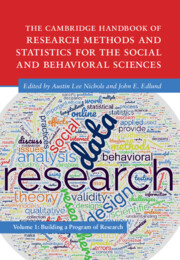 The Cambridge Handbook of Research Methods and Statistics for the Social and Behavioral Sciences
The Cambridge Handbook of Research Methods and Statistics for the Social and Behavioral Sciences from Part IV - Statistical Approaches
Published online by Cambridge University Press: 25 May 2023
What are statistics and why do we need them? This chapter introduces descriptive statistics and then creates a bridge from describing data concisely to answering questions using hypothesis testing and inferential statistics. The chapter leads the reader to an understanding of how descriptive statistics summarize and communicate meaning, based on data, and how they underpin inferential statistics. Research study examples, figures, and tables throughout the chapter explain the topics addressed by applying the ideas discussed. The chapter begins with the basics of descriptive statistics – normal distributions, options for displaying frequencies, measures of central tendency and variability, and correlations. The transition to inferential statistics covers standardization and the z-score, sampling, confidence intervals, and basics of hypothesis testing including Type I and II errors. We then introduce inferential statistics using three methods – t-tests, one-way analysis of variance (ANOVA), and chi-square tests.
To save this book to your Kindle, first ensure no-reply@cambridge.org is added to your Approved Personal Document E-mail List under your Personal Document Settings on the Manage Your Content and Devices page of your Amazon account. Then enter the ‘name’ part of your Kindle email address below. Find out more about saving to your Kindle.
Note you can select to save to either the @free.kindle.com or @kindle.com variations. ‘@free.kindle.com’ emails are free but can only be saved to your device when it is connected to wi-fi. ‘@kindle.com’ emails can be delivered even when you are not connected to wi-fi, but note that service fees apply.
Find out more about the Kindle Personal Document Service.
To save content items to your account, please confirm that you agree to abide by our usage policies. If this is the first time you use this feature, you will be asked to authorise Cambridge Core to connect with your account. Find out more about saving content to Dropbox.
To save content items to your account, please confirm that you agree to abide by our usage policies. If this is the first time you use this feature, you will be asked to authorise Cambridge Core to connect with your account. Find out more about saving content to Google Drive.